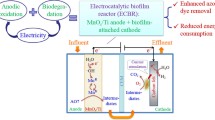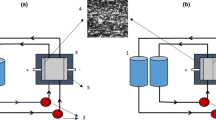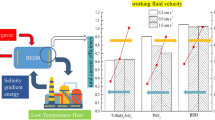Abstract
The electrochemical oxidation of synthetic textile effluent containing Azo-dye Acid Violet 7 (200 mg L−1) was investigated using planar disk electrodes placed in a one inlet–outlet (I–O) cylindrical reaction chamber. Two different I–O configurations were studied, one parallel and the other perpendicular to the electrodes. Both reactors were equipped with boron-doped diamond (BDD) anodes and titanium cathodes. The effect of cell design on the hydrodynamic characteristics and efficiency of the reactors in terms of colour and chemical oxygen demand (COD) removal was studied. Mass transfer coefficient (Km) values of 1.86 × 10−5 m s−1 and 2.56 × 10−5 m s−1 were obtained for the parallel and perpendicular I–O flow reactors, respectively, using the limiting current technique. The degradation results indicated that the colour elimination was quite efficient regardless of the type of reactor used and that complete colour removal could be reached in less than 80 min at applied current density of 30 mA cm−2 and above. However, higher COD removal efficiency was always achieved in the parallel I–O flow cell compared to perpendicular I–O flow reactor at all of the current densities studied, which can be attributed to the possibility of some stagnation in the lateral regions of the electrodes. These favour a longer contact time between the pollutants and the anode, also favouring its removal. Besides, similar electric energy consumption per g COD removal was observed during the treatment with either reactors; thus demonstrating the suitability of the parallel I–O flow cell for the efficient and economic treatment of textile effluent.
Graphical abstract









Similar content being viewed by others
References
Sales Solano AM, Costa de Araújo CK, Vieira de Melo J, Peralta-Hernandez J, Ribeiro da Silva D, Martinez-Huitle CA (2013) Decontamination of real textile industrial effluent by strong oxidant species electrogenerated on a diamond electrode: viability and disadvantages of this electrochemical technology. Appl Catal B Environ 130–131:112–120
Aquino JM, Pereira GF, Rocha-Filho RC et al (2011) Electrochemical degradation of a real textile effluent using boron-doped diamond or β-PbO2 as anode. J Hazard Mater 192:1275–1282
Hajjaji W, Ganiyu SO, Tobaldi DM, Andrejkovičová S, Pullar RC, Rocha F, Labrincha JA (2013) Natural Portuguese clayey materials and derived TiO2-containing composites used for decolouring methylene blue (MB) and orange II (OII) solutions. Appl Clay Sci 83–84:91–98
Thiam A, Brillas E, Centellas F, Cabot PL, Sirés I (2015) Electrochemical reactivity of Ponceau 4R (food additive E124) in different electrolytes and batch cells. Electrochim Acta 173:523–533
Brillas E, Martínez-Huitle CA (2015) Decontamination of wastewaters containing synthetic organic dyes by electrochemical methods. An updated review. Appl Catal B Environ 166–167:603–643
Konstantinou IK, Albanis TA (2004) TiO2-assisted photocatalytic degradation of azo dyes in aqueous solution: kinetic and mechanistic investigations. Appl Catal B Environ 49:1–14
Panizza M, Cerisola G (2009) Direct and mediated anodic oxidation of organic pollutants. Chem Rev 109:6541–6569
Martínez-Huitle CA, Panizza M (2018) Electrochemical oxidation of organic pollutants for wastewater treatment. Curr Opin Electrochem. https://doi.org/10.1016/j.coelec.2018.07.010
Martínez-Huitle CA, Rodrigo MA, Sirés I, Scialdone O (2015) Single and coupled electrochemical processes and reactors for the abatement of organic water pollutants: a critical review. Chem Rev 115:13362–13407
Rodrigo MA, Oturan N, Oturan MA (2014) Electrochemically assisted remediation of pesticides in soils and water: a review. Chem Rev 114:8720–8745
Moreira FC, Boaventura RAR, Brillas E, Vilar VJP (2017) Electrochemical advanced oxidation processes: a review on their application to synthetic and real wastewaters. Appl Catal B 202:217–261
Comninellis C, Pulgarin C (1991) Anodic-oxidation of phenol for waste-water treatment. J Appl Electrochem 21:703–708
Marselli B, Garcia-Gomez J, Michaud PA, Rodrigo MA, Comninellis C (2003) Electrogeneration of hydroxyl radicals on boron-doped diamond electrodes. J Electrochem Soc 150:D79–D83
Ganiyu SO, van Hullebusch ED, Cretin M, Esposito G, Oturan MA (2015) Coupling of membrane filtration and advanced oxidation processes for the removal of pharmaceutical residues: a critical review. Sep Purif Technol 156:891–914
Zaky AM, Chaplin BP (2014) Mechanism of p-substituted phenol oxidation at a Ti4O7 reactive electrochemical membrane. Environ Sci Technol 48:5857–5867
Zaky AM, Chaplin BP (2013) Porous substoichiometric TiO2 anodes as reactive electrochemical membranes for water treatment. Environ Sci Technol 47:6554–6563
Martínez-Huitle CA, Ferro S, De Battisti A (2005) Electrochemical incineration of oxalic acid: reactivity and engineering parameters. J Appl Electrochem 35:1087–1093
Wragg AA, Leontaritis AA (1997) Local mass transfer and current distribution in baffled and unbaffled parallel plate electrochemical reactors. Chem Eng J 66:1–10
Quiroz MA, Martínez-Huitle UA, Martínez-Huitle CA (2005) Mass transfer measurements in a parallel disk cell using the limiting current technique. J Mex Chem Soc 49:279–283
Oduoza CF, Wragg AA (2000) Effects of baffle length on mass transfer in a parallel plate rectangular electrochemical cell. J Appl Electrochem 30:1439–1444
Oduoza CF, Wragg AA, Patrick MA (1997) The effects of a variety of wall obstructions on local mass transfer in a parallel plate electrochemical flow cell. Chem Eng J 68:145–155
Podlaha EJ, Fenton JM (1995) Characterization of a flow-by RVC electrode reactor for the removal of heavy metals from dilute solutions. J Appl Electrochem 25:299–306
Polcaro AM, Vacca A, Palmas S, Mascia M (2003) Electrochemical treatment of wastewater containing phenolic compounds: oxidation at boron-doped diamond electrodes. J Appl Electrochem 33:885–892
Szpyrkowicz L, Radaelli M (2006) Scale-up of an electrochemical reactor for treatment of industrial wastewater with an electrochemically generated redox mediator. J Appl Electrochem 36:1151–1156
Pulgarin C, Adler N, Peringer P, Comninellis C (1994) Electrochemical detoxification of a 1,4-benzoquinone solution in waste-water treatment. Water Res 28:887–893
Li X, Wu Y, Zhu W, Xue F, Qian Y, Wang C (2016) Enhanced electrochemical oxidation of synthetic dyeing wastewater using SnO2-Sb-doped TiO2-coated granular activated carbon electrodes with high hydroxyl radical yields. Electrochim Acta 220:276–284
Yapici S, Patrick MA, Wragg AA (1994) Electrochemical study of mass transfer in decaying annular swirl flow. J Appl Electrochem 24:685–693
Comninellis C, Nerini A (1995) Anodic oxidation of phenol in the presence of NaCl for waste-water treatment. J Appl Electrochem 25:23–28
Martinez-Huitle CA, Quiroz MA, Comninellis C, Ferro S, De Battisti A (2004) Electrochemical incineration of chloranilic acid using Ti/IrO2, Pb/PbO2 and Si/BDD electrodes. Electrochim Acta 50:949–956
Bonfatti F, Ferro S, Lavezzo F, Malacarne M, Lodi G, De Battisti A (1999) Electrochemical incineration of glucose as a model organic substrate I. Role of the electrode material. J Electrochem Soc 146:2175–2179
Wragg AA, Tagg DJ, Patrick MA (1980) Diffusion-controlled current distributions near cell entries and corners. J Appl Electrochem 10:43–47
Pletcher D (1984) Electrochemical engineering. In: Industrial Electrochemistry Springer, Dordrecht, pp 52–87
Chin D-T, Tsang C-H (1978) Mass transfer to an impinging jet electrode. J Electrochem Soc 125:1461–1470
Ganiyu SO, Oturan N, Raffy S, Esposito G, van Hullebusch ED, Cretin M, Oturan MA (2017) Use of sub-stoichiometric titanium oxide as a ceramic electrode in anodic oxidation and electro-Fenton degradation of the beta-blocker propranolol: degradation kinetics and mineralization pathway. Electrochim Acta 242:344–354
Martínez-Huitle CA, De Battisti A, Ferro S, Reyna S, Cerro-López M, Quiro MA (2008) Removal of the pesticide methamidophos from aqueous solutions by electrooxidation using Pb/PbO2, Ti/SnO2, and Si/BDD Electrodes. Environ Sci Technol 42:6929–6935
Panizza M, Martinez-Huitle CA (2013) Role of electrode materials for the anodic oxidation of a real landfill leachate—Comparison between Ti–Ru–Sn ternary oxide, PbO2 and boron-doped diamond anode. Chemosphere 90:1455–1460
El-Ghenymy A, Cabot PL, Centellas F, Garrido JA, Rodríguez RM, Arias C, Brillas E (2013) Electrochemical incineration of the antimicrobial sulfamethazine at a boron-doped diamond anode. Electrochim Acta 90:254–264
Ganiyu SO, Oturan N, Raffy S, Cretin M, Esmilaire R, van Hullebusch ED, Esposito G, Oturan MA (2016) Sub-stoichiometric titanium oxide (Ti4O7) as a suitable ceramic anode for electrooxidation of organic pollutants: a case study of kinetics, mineralization and toxicity assessment of amoxicillin. Water Res 106:171–182
Acknowledgements
Financial support from National Council for Scientific and Technological Development (CNPq - 465571/2014-0; CNPq - 446846/2014-7 and CNPq - 401519/2014-7) and FAPESP (2014/50945-4) are gratefully acknowledged.
Author information
Authors and Affiliations
Corresponding authors
Rights and permissions
About this article
Cite this article
Brito, C.N., Ferreira, M.B., de Moura Santos, E.C.M. et al. Electrochemical degradation of Azo-dye Acid Violet 7 using BDD anode: effect of flow reactor configuration on cell hydrodynamics and dye removal efficiency. J Appl Electrochem 48, 1321–1330 (2018). https://doi.org/10.1007/s10800-018-1257-4
Received:
Accepted:
Published:
Issue Date:
DOI: https://doi.org/10.1007/s10800-018-1257-4




